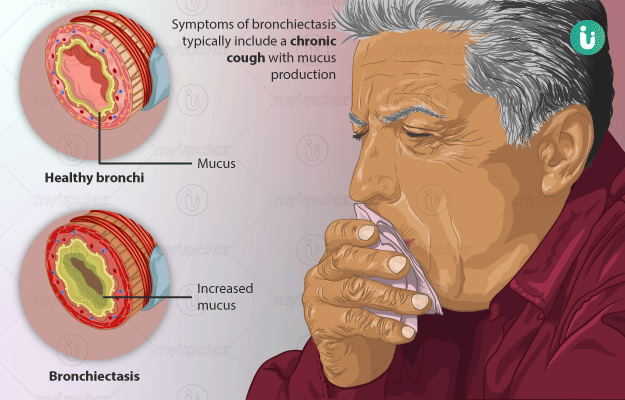What is bronchiectasis?
Bronchiectasis is a chronic condition of the lungs in which the bronchial walls are thickened due to an infection of the airway. The bronchial walls also become flabby and scarred, resulting in permanent damage.
In this condition, the airways lose their ability to clear out mucus. The mucus gets accumulated and creates a favourable environment for the growth of bacteria, leading to repeated lung infections.
Such repeated infections in the lungs result in reduced ability to move air in and out of the airways, which, in turn, causes a reduction in oxygen supply to the vital organs.
What are its main signs and symptoms?
The common symptoms of bronchiectasis are:
- Frequently coughing up phlegm
- Breathlessness which increases during exertion
- Whistling sound while breathing (wheezing)
- Pain in chest
- Clubbing of fingertips – tissue below the nail thickens and fingertips become round and bulbous
- Over time, blood with mucus may be coughed up
What are its main causes?
In most instances, bronchiectasis is the result of infection of the airway which causes thickening of the walls. However, in some cases, the cause is not known (idiopathic bronchiectasis).
A few of the causative factors include:
- History of chronic lung diseases like pneumonia, whooping cough or tuberculosis
- Rheumatoid arthritis
- Crohn’s disease, which is an inflammatory bowel disease
- Reduced immunity (immunodeficient status)
- Cystic fibrosis – a genetic disorder where mucus is clogged up in the airway. This is the most favourable environment for the growth of bacteria
- Chronic obstructive pulmonary disease (COPD)
How is it diagnosed and treated?
The doctor listens for abnormal lung sounds with a stethoscope and may advise complete blood tests to check for infection.
- Sputum test – to check whether it contains bacteria or fungi
- X-ray of the chest or CT scan
- Pulmonary function test measures the quantity of air breathed in and out and how fast it is done. It also checks how much oxygen is passed into the blood
- Sweat test to check for cystic fibrosis
- Bronchoscopy may be done to view the inside of the airways
Bronchiectasis is generally managed as follows:
- Medicines like antibiotics, expectorants and mucolytics are commonly used. Other medicines like bronchodilators and corticosteroids are used as per the need
- Hydration – drinking plenty of water is recommended, as it moistens the airways and reduces the stickiness of mucus so that it can be easily coughed out
- Chest physical therapy
- Oxygen therapy
Living with bronchiectasis:
- If you suffer from bronchiectasis, you should take precautions to avoid lung infections like pneumonia. Wash your hands frequently to avoid bacterial infections and also check with your doctor for pneumonia vaccines.
- You should follow healthy eating habits, avoid smoking and stay well hydrated.
- Being physically active can help as well.

 Doctors for Bronchiectasis
Doctors for Bronchiectasis  OTC Medicines for Bronchiectasis
OTC Medicines for Bronchiectasis



















